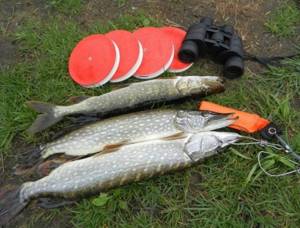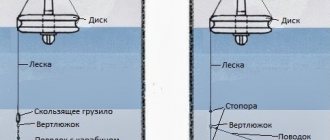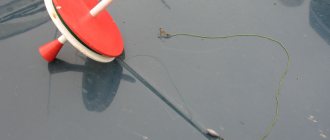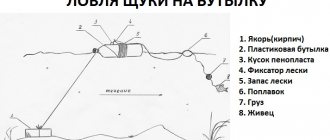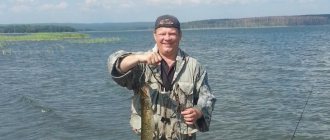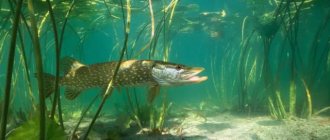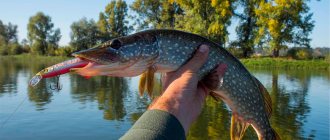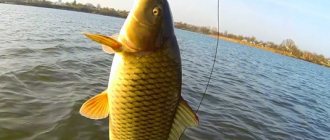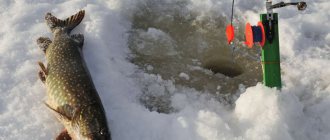According to real fishermen, mugs are the best way to catch pike. The advantage of this method is that you do not need to know exactly where these predatory fish are hiding. The circle, moving, itself discovers their location. Water flow and wind help with this. Therefore, catching pike with mugs is an ideal method. But this method is, of course, only suitable for summer fishing. In winter, of course, you won’t be able to cut through the surface of the water on a boat and ensure the movement of a circle with bait.
How to prepare for fishing using circles
Before fishing in this way, you need to conduct a study of the state of the bottom of the reservoir in which you are going to do this. For this purpose you will need a device such as an echo sounder. Although you can limit yourself to jig probing.
To drag caught fish into your boat, you will need a landing net and a hook. You can't do without reinforced gloves , because if you decide to do without this attribute, you risk cutting your hands on the sharp fins of the predatory fish you are going to hunt.
For fishing to be successful, you will have to stock up on live bait , since pike is a predator and will only bite on small, tasty fish. Suitable live bait include: rotan, roach, rudd, bream, crucian carp and gudgeon.
The fish that your pike will bite on will need to be kept in something during transportation and storage. To do this, you will need to use a canoe with a grate, thanks to which you will be able to remove the bait without putting your hands in the water.
You can use not only live fish as bait , but also dead ones . Just for the pike to bite on it, you need to cut its sides. Blood will flow out through the cuts and thus the dead fish will attract your potential prey.
We also recommend reading:
Budget spinning reels Riobi Exiya Model range of Salmo wobblers and the Salmo Hornet catalog Features of crucian carp killer tackle and how to make such equipment Diagram of how to learn how to tie a hook to a fishing line
In addition to all of the above, you will need leashes with hooks in reserve and an extractor with which you will remove hooks from caught prey.
Features of fishing with mugs: fishing techniques and tactics
There are no specific features when fishing for pike with a circle, since this is the simplest and most effective method.
There is practically no need for the participation of the fisherman here; the main thing is to monitor the fluctuations of the circle and manage to drag the fish into the boat in time.
Often, many professional fishermen place as many circles around the boat as possible at different distances to increase fishing efficiency.
Choosing a place and time for catching pike with mugs
The key to an excellent bite will be the correct choice of place for fishing. You need to swim by boat almost to the very middle of the reservoir, since a large amount of algae and other underwater vegetation is constantly collected near the shores, which can make it difficult to catch pike with a circle.
IMPORTANT! Pike is a very picky predator, as it actively begins to bite only at certain hours, so you need to arrange your gear exactly according to the schedule.
The optimal time for arranging gear is from 4 to 6 am. At this time, the predator is as active and hungry as possible, so it goes out hunting for prey.
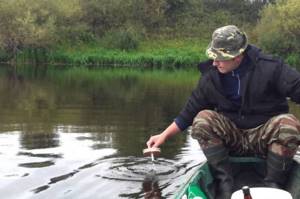
How to correctly place a circle on a pike?
Many novice fishermen set up their gear in such a way that the current carries it very close to the boat. For the bite to be productive, you need to move the circle with the current or in the direction of the wind. In this case, it will dangle on the waves and thereby vibrate the bait on the hook, which awakens the hunter’s instincts in the pike - and the fish swallows the bait.
Features of fishing for pike with a circle in summer and autumn
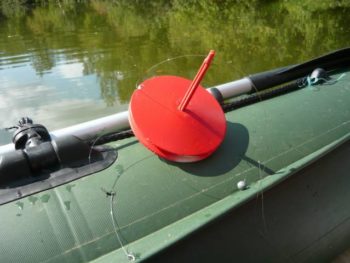
Many fishermen notice that the fall bite is very different from summer fishing. The whole point is that in the fall the algae begin to die off and rise closer to the surface of the water column, so you need to choose the minimum depth.
All fish that feed on vegetation rise higher to feast on algae, so the pike rises after the representatives of its food chain.
In summer, pike, on the contrary, drop as low as possible, since the water warms up greatly. In this case, you need to release the line from the circle to the maximum mark so that the load falls straight to the bottom. This method is also suitable for fishing in reservoirs where there is a strong current.
Making a mug for pike with your own hands
So, let's get to the equipment . We take polystyrene foam. Its thickness should be 1.5 - 2 centimeters. Using a pencil and compass, draw a circle with a diameter of 1.5 millimeters. Now we take a well-sharpened knife and cut out our workpiece.
At the next stage of work, you need to make a groove on the end side of the future circle. Its depth should be 1 centimeter. To make our groove smooth, we will process it with sandpaper. We make a hole in the center of the circle. Its diameter is from 6 to 8 millimeters.
You need to make two slits on the top of the circle. They are needed to secure the fishing line.
Now you need to make a pin . It is made from a wooden plank. It is ground down so that its shape eventually becomes cone-shaped. Naturally, you need to make a groove at the end so that there is something to cling to the fishing line. Next, the disk and pin need to be painted. The upper part of the disk is red, the lower part is white. And the pin is painted exactly the opposite - the bottom is red, the top is white.
Fishing tackle
In terms of design parameters, the device of the circle device is identical to the device of the girder, where live bait is also used as bait, mounted on a sharp hook, and freely moving around the water area, luring the predator with its activity.
But there is still a distinctive feature: at the first bite, the device must be taken out in order to hook the prey.
For the device of circle gear the following is used:
- Circle. The material can be wood, in particular linden, or another durable and at the same time light material. Although linden has good working qualities, it requires special attention during preparation; moreover, it loses its lightness from frequent contact with water. As a solution, you can use packaging foam for the mug. The standard thickness of the circle is 25 - 30 mm, and the diameter is 13 - 15 cm. At the end of the product there is a special recess for storing fishing thread, along the circumference of the tackle. At the top of the disk, there are cuts on the outside for attaching the scaffolding, and in the center there is a hole for a wooden antenna. To paint the product, 2 colors are used: red on top and white on the bottom.
- Pin (antenna). The length of the pin must correspond to the diameter of the circle; if the diameter of the circle is 13 cm, then the length of the pin will also be 13 cm. The height of the mast must be adjusted taking into account the weight of the bait and the wind force. Spruce, linden, pine, and lightweight plastic are suitable as blanks for the antenna. The top of the pin is painted white and the head red. You can apply white or black stripes, so visibility when biting will be much better.
- Fishing line. The best option for fishing thread for a circle is a colorless monofilament with a thickness of 0.3 - 0.5 mm with a sufficient margin of safety. There is an opinion that it is better to use a braided cord, but when fishing for fish it can seriously injure your hands, and monofilament is safer in this regard. It’s good to make a small supply of fishing line; it’s enough to measure 15 m. To fix it to the disk, you need to use a double loop. For hunting at great depths, it is recommended to put a square piece of rubber on the cord or fishing line, this way you can fix the depth.
- Sinker. Here it is rational to use a sliding version of the weight with a weight of 15 g.
- Hook or tee.
- Metal leash. The length of the leash should be 40 cm and the thickness 0.3 mm. Using a swivel, the metal leash is connected to the fishing thread, and a tee is mounted to it.
Depending on the fishing conditions, live bait is mounted as follows:
- Under the gills , if hunting is carried out in a body of water with a weak current.
- Under the dorsal fin , if the catch of a toothy predator takes place in a body of water with a strong current.
Installation of circles
So, you have made your gear and chosen a place where you will catch pike. Now you need to install fishing mugs .
Each angler is allowed to have a maximum of five fishing gear. If you fish with someone else in the same boat, you can use 10 tackles.
Take the circle and wind the cord from it. The length should be such that the bait is at a depth of half a meter to one and a half meters from the bottom. Now we attach a small float made of cork to the end. We insert the cord into special cuts on the outside of the circles. Wrap the cord around the pin a couple of times. We attach bait and lower this structure into the water. The distance between circles should be from 5 to 10 meters. You need to monitor the tackle from a distance so as not to spook the fish, and, at the same time, not to lose sight of the mugs. It's best to just have them follow the boat.
If the current is strong, then it is better to anchor the tackle , otherwise they will simply be carried away. A fishing line is used as anchors, which is tied with one ring to a pin, and the other to thickets and bushes. If there are no thickets, then they take a stick and tie a cord weighted with a weight to it, and the other end of the stick is attached to the thickest part of the pin.
If a pike pecks at your bait, the circle first turns over with its white side up, and then rotates, and the fishing line unwinds. When the movements stop, it means the fish has taken the bait. After which the circle begins to rotate again, which means that the pike is trying to go into cover. At this moment you need to drag it into the boat, pulling up the fishing line, and help yourself with the hook.
Equipment for pike fishing circles
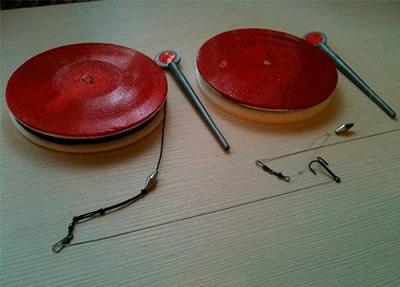
Speaking of color preferences, I would recommend black, which is not so noticeable in the water in any light. In order to equip a circle for pike you will need 15–20 meters of fishing line. A piece of fishing line is tied with a loop into the line guide of the disk and wound up, equipping the installation with the following elements. Further equipment will require the installation of a sliding sinker in the shape of a barrel or olive, weighing from 8 to 10 grams. In this case, I would immediately like to note that for anchoring the gear in a certain place, the mass of the load will differ significantly in size, which will be separately described in the chapter devoted to this issue a little later. After threading a lead sinker onto the monofilament line, a damper bead is installed, which will prevent deformation of the knot that attaches the swivel to the cord.
The leash and tee are selected according to the reliability criteria required for catching a toothy and powerful trophy. It is rational to use Kevlar with a length of 25–30 cm or fluorocarbon with a diameter of 0.4 mm, all in the same cut, as leashes. Leashes made from these materials are distinguished by their softness, lack of memory, which is the problem with their metal counterparts, which curl into a pig’s tail after a bite, and high strength. On accessories made of Kevlar and fluorocarbon, live bait is less injured and has a greater degree of freedom to move, which benefits the angler in saving live bait material and luring a predator.
Practice has shown that when fishing with circle gear, a double sliding type of hook is convenient, selected in sizes harmonious with the size of the live bait. Such hooks are quick to install and they are less alarming than tees when catching fish, which increases the chances of successfully catching a trophy from a larger number of bites.
What are fishing mugs
Pike fishing mugs are a very simple device that does an excellent job both with its main task and with some additional ones.
Read here How to attach live bait - methods of attaching bait to a hook for catching different types of fish (125 photos + video)

But it is also a container for storing and carrying gear in the form of fishing line, hooks and other things. In addition, the mugs are a good indicator that the bite is in progress.
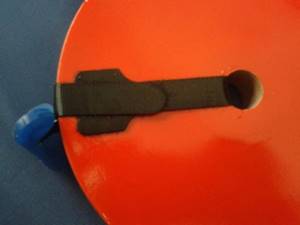
The circle is made of polystyrene foam, which floats perfectly on water. Sometimes the gear is attached to a wooden base.
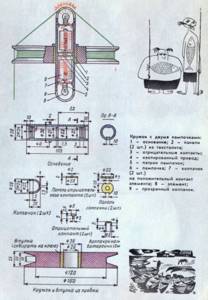
In the center of the circle there is a hole into which an axis in the form of a plastic pin is inserted. Inside there is a special slot for winding the working line, at the end of which there is equipment for fishing.
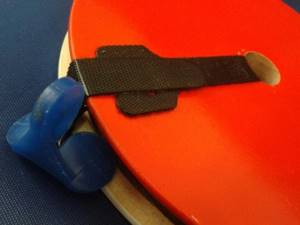
When fishing begins, the pin is inserted into the center of the circle with the spherical part on the underside. There is a hole at the top into which the fishing line is inserted. The line is lowered to the depth required with the bait already attached to the hook.
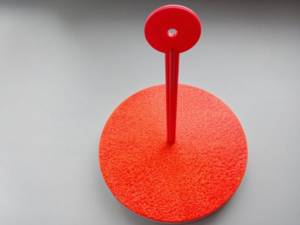
The circle looks red side up, white side down. As soon as the pike starts biting, the circle turns over, which is a signal to the angler.
